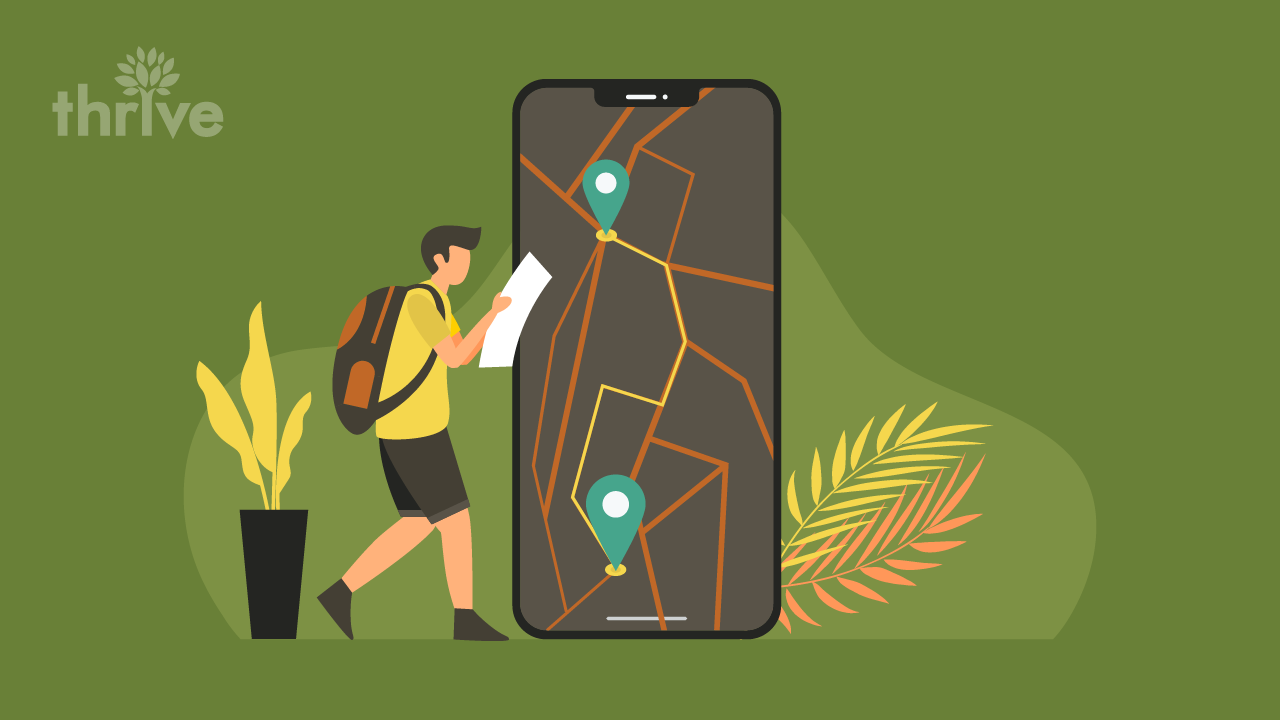Generating more leads for your franchise or multi-location business has become one of the most anticipated benefits of search engine optimization (SEO). These are no random franchise leads either, but qualified, ripe-for-conversion ones.
But such results do not happen by accident. Whether you’re a franchisor or franchisee, you need to incorporate franchise SEO practices properly into your franchise marketing. Specifically, you must employ local SEO, which optimizes each of your locations and provides correct information to Google to improve your online presence. “Doing so allows search engines to distinguish between the different locations and present the right one to people who search for it,” said Shannon Thammasiene, Thrive’s director for SEO services.
Mostly, the people who search for your products or services have buying intent, some intense and urgent. Being better ranked in their location-specific search results then boosts your chances of capturing them as leads. Opportunities open up for both roles in the franchising framework in this case. Franchisors can attract additional franchisees as a part of their expansion. On the other hand, franchisees can convert more customers or clients to make their venture successful in their respective areas.
Stick with us as we dish out franchise marketing and local SEO tips to help you ramp up your franchise lead generation efforts and achieve coveted results.
Some questions we strive to answer in this article:
• What is franchise marketing, what is enterprise SEO and what is local SEO?
• What enterprise SEO strategy tips and tricks should you apply to acquire more leads?
• Why should you work with an enterprise SEO agency?
Enterprise SEO, Local SEO and You
The franchise strategy tips we’re about to share are connected with one another. An experienced franchise marketing agency can keep track of these components for you, but it also pays to learn some of the strategies yourself. Here’s a quick introduction to the basics, which you need to master if you’re to attract high-value franchise leads:
What is franchise marketing?
Any form of marketing for franchises falls under this category. Broadcast, print and radio are considered the traditional way of franchise advertising. So are coupons, direct mail, flyers and other types of word-of-mouth marketing.
While the traditional approaches still exist, the rise of mobile devices and faster internet speeds has resulted in changes to consumer behavior. For example, according to Google, 63 percent of shopping starts online, whether the purchase ends online or in a physical store. This has shifted the focus to digital marketing, including franchise SEO.
What is enterprise SEO?
Enterprise-level SEO refers to large-scale optimization involving companies that serve a broad market. We’re talking about websites with thousands to millions of pages, often with complex requirements in areas like project management, collaboration and automation (Search Engine Journal, 2020).
By this definition alone, franchise SEO is treated at the enterprise level because of 1) the sheer number of pages a corporate website has (e.g., it may have 200 location pages) and 2) the broad market a franchise seeks to capture.
What is local SEO for franchises’ importance in franchise lead generation?
While branding guidelines can be set at the corporate or franchisor level, an enterprise SEO strategy should account for both national and local searches. What hangs in this balance is not just corporate branding consistency but also the local search performance of each business location. Also, do franchisees distribute corporate content or create their own content? These are the kinds of complications that enterprise SEO aims to tackle through local SEO.
Because of this complex and complicated nature of optimizing for franchises, businesses may benefit from the perspective of a well-versed enterprise SEO agency. For instance, Thammasiene said you have to keep track of logins and access many profiles, such as your website, Google Business Profile (formerly known as Google My Business) and Search Console account. “For multi-locations, this is especially important to have under control as there can be many cooks in the kitchen,” she added.
6 Ways To Increase Your Franchise Leads
Now it’s time to deploy local SEO services and strategies to drive leads to your franchise locations. Here are six tips for achieving your enterprise marketing objectives:
1. Build Out Pages for Each Location
Multiple-location or franchise SEO requires you to create pages for each location on your site, making it easy for you to reach the right customers. When you apply this franchise strategy, your pages can rank high for relevant search terms, and this level of visibility can drive visitors to your site. Once prospects are on your site, you can direct them to the nearest storefront or location.
Sounds doable, right?
A local SEO company with broad experience would tell you, well, it depends. Whether it’s 20 or 200 locations – our enterprise SEO firm can deal with up to thousands – this strategy can only be successful with the completion of the following steps:
• Keyword research: Identifies what keywords to use for each location and how much traffic you can capture if you rank well for them
• Competitive analysis: Directs your local SEO services or campaigns for each location, i.e., on-page optimization or off-page optimization (link building)
• Logical URL structure: Determines how you write your location URLs. A uniform resource locator or URL is the unique web address of each of your website pages. When it comes to URL structure, choose one system of writing and stick with it, said Thammasiene. This way, you can make navigation easy for users and indexing efficient for search engines.
For example, a local SEO agency with multiple locations can use one of the following URL structures for all its location pages:
example.com/locations/ for a list of all the locations
example.com/locations/Texas/ for a list of all the locations in a particular state
example.com/locations/Texas/Dallas/ for a list of locations in a city
2. Create and Optimize Your Google My Business Listing
When users search for a local business on Google, the search engine displays a map and a list of three options at the top of the page. These are search results for Google Maps and Google Local 3-Pack, two Google properties that provide brick-and-mortar and service-area businesses (the latter include plumbers, cleaners, etc.) with a prime spot on the search engine results pages (SERPs).
As 93 percent of local searches feature Google 3-Pack results, being featured in this property should boost your brand awareness, relevance and credibility. If you’re marketing for franchises, you must be positioned in one of its coveted spots, and the first step to doing that is to claim your Google Business Profile or Google My Business (GMB) listing.
Setting up a profile should be easy. But optimizing it may entail the enlistment of a local SEO company. Just consider the intricacy of Google’s guidelines, which you must adhere to completely for your locations to rank in these high-value results. An expert in enterprise SEO services should be able to help you nail tasks like maintaining separate listings for each location, including storefront information that reflects your real-world identity and writing descriptions that engage users right away.
3. Ensure NAP Consistency
Local citations of your franchise locations may occur anywhere on the web, from Google Business Profile or GMB and Yelp to blogs and public databases. Citations are online mentions of your name, address and phone number (NAP). And your NAP must match what’s listed on your website because Google uses citations to rank local businesses accurately on Google Maps.
Franchise marketing agency professionals stress that this is no small matter to your enterprise marketing efforts. Even slight variations, such as writing “St” in one place and “Street” in another, should be fixed to maintain Google’s confidence in your business. In turn, accurate and consistent NAP across the board bolsters your reach and search rankings.
4. Leverage Local Keywords and Geo-Modifiers
An experienced local SEO agency would suggest strategically placing location-based keywords, such as “fencing installation contractors in Dallas, TX.” Here are a few ideas on how to position your site in front of high-intent leads using geo-modifiers:
• Include them in your title, meta description and headers.
• Use them in your content naturally, integrating both exact keywords and their variants.
• Maximize long-tail keywords by addressing the problem embedded in them, e.g., how to find the best enterprise SEO company.
Now, what about keywords without geo-modifiers? As Thrive’s director of enterprise SEO services, Thammasiene knows not to waste non-geo-modifiers in trying to rank locally. But pulling off this trick may require the local SEO agency sleight of hand: the consistent nailing of enterprise SEO strategy execution.
5. Employ Unified Branding
As a franchisee doing franchise advertising, branding or marketing, you automatically benefit from the brand equity your franchisor has built. So, even if you’re free to develop your own website and ad assets, make sure people recognize your logo and associate other visual elements like fonts, icons and color palette with the established corporate identity.
On the other hand, franchisors are responsible for an overall franchise strategy that includes the generation of brand guidelines. Enterprise SEO firm experts cite Starbucks’ brand expression guide as an ideal model for this. The stylebook emphasizes the look and feel of the Starbucks logo, which contributes to the customer experience, and enterprise SEO company pros may even argue it keeps the sales growing.
6. Encourage Customers To Leave Reviews
In marketing for franchises nowadays, the top enterprise SEO agency whizzes advise tapping into the power of positive reviews. Consider this: 79 percent of consumers trust online reviews as much as they do personal recommendations from family and friends. But that’s not just it. A good 94 percent admit they’re likely to use a business with more positive reviews.
To increase good reviews, however, you should proactively gather them. You must ask for them, make it easy for existing customers to leave them and then respond to negative reviews. Does it sound daunting? Don’t worry because this is something a dedicated local SEO company can do if you have neither the expertise nor bandwidth to implement it.
Why Work With an Enterprise SEO Company?
As Thammasiene said earlier, local SEO for franchises has many components. With Google’s guidelines and best practices also changing more often, it’s valuable to have an experienced enterprise SEO firm that can stay on top of it all for you.
At Thrive, we align strategies with each individual client’s objectives, including enhanced franchise lead generation. Our offerings also extend from local SEO services to a wide range of digital marketing solutions. We’re not kidding when we say you get access to our team of industry experts. A client of ours with a multi-location property restoration company attested to this:
When you have some concerns or an issue you need to address, there are multiple people who can come to the table to address the concerns from their knowledge base versus another agency that would just give you one or two people.
That synergy, by the way, brought about 46,000 qualified calls for this client in 2020.
It’s Your Turn
In this blog, we answered basic questions like What is franchise marketing? and What is local SEO? We also laid down steps on how to drive more leads using local SEO for franchises.
But knowing is one thing and implementing is another. Armed with this basic understanding, you should be able to assess what you can and can’t do. When you’re leaning toward the latter, it’s better to grow your lead generation efforts with guidance from a trusted local SEO agency.
Like our multi-location client, stick with the best franchise marketing agency to deploy a variety of enterprise SEO services: Thrive. Our suite of franchise SEO solutions includes keyword research and strategy, local SEO, on-page SEO, link building and franchise advertising.
We also offer voice search optimization, local listing management, online reputation management (ORM), audience and competition analysis, geo-specific content marketing and mobile SEO. Speak with one of our specialists and learn how Thrive’s franchise SEO services can open up an avenue for your locations to gain solid leads.





